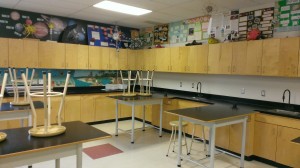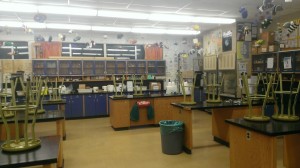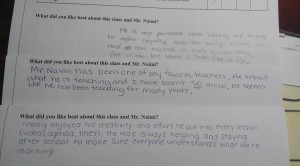Creating a classroom organized and characterized by mutual respect makes it much easier to teach effectively (Dusenbury, 2012). To promote learning, one of the most important things teachers can do is create classroom environments where their students feel safe. It’s important to create a classroom environment where students feel safe in order to learn and secure in order to want to participate.
Some of the ways I plan to create safe and supportive environments, build relationships, foster Social Emotional Learning, and prevent problems are as follows:
- Concern and Care: In order to establish a caring classroom environment, learning students’ names soon after meeting them is very important as well as show genuine concern towards them and their lives outside of the classroom.
- Teacher Availability: Compared to elementary, secondary teachers don’t see their students as much. Therefore, I will make myself available outside of class time for students to come and seek help or start a dialogue. Research shows relationships with adults in the secondary settings are among the most important predictors of success; students reporting greater connectedness to secondary teachers displayed lower rates of emotional distress, suicidal ideation, violence, substance abuse, and early sexual activity (Hamre & Pianta, 1997).
- Student Participation: Respect what each student has to say; that is, I will make them feel like he/she can participate, ask and answer questions without the threat of being negatively judged (Dusenbury, 2012). Caring teachers model caring (Noddings, 2006). Teach other students how to listen and engage in conversation respectively; encourage them to discuss ideas and interact with one another.
- Feedback: Encourage constructive student feedback about my own instructional strategies. Building a democratic classroom is suggested to decrease bullying at school (Rodkin, 2011).
- Physical Space: Organize the physical space of my classroom to invite movement and interaction (Dusenbury, 2012). This is sometimes difficult in a science classroom but I will try to set up the space so students can pull their desks or chairs together to do group work. Movement around the classroom helps teaching become more engaging and it also helps with classroom control.
- Teacher Collaboration: Work with other teachers and administrators to create supportive environment around the school (i.e. school field, hallways, etc.). Noddings (2006) mentions, creating a caring environment doesn’t fall on the shoulders of one or two teachers who are considered “specialists” on SEL; the responsibility is on all teachers, no matter their teaching specialization.
- Student Relationships: Every now and then, encourage students of different cliques/groups to form relationships with their peers by randomly generating groups for class discussion.
- Student Accommodation: Provide students with multiple options regarding projects/assignments. I will also value student progress and take the time to celebrate their individual and/or group achievements.
References
Dusenbury, L. (2012). Creating A Safe Classroom Environment. Retrieved from www.educationworld.com/a_curr/creating-safe-classroom-environment-climate.shtml
Hamre, B. K., & Pianta, R.C. (2006). Student-teacher relationships. In G. G. Bear & K. Minke (Eds.), Children’s Needs III: Development, prevention, and intervention (pp.59-71). Bethesda, MD: NASP.
Noddings, N. (2006). Handle with care. Greater Good, 3(1), 18-21.
Rodkin, P.C. (2011). Bullying-And the power of peers. Educational Leadership, 69, 10-16.



Creating a positive classroom environment fosters student engagement and motivation. It encourages collaboration and open communication, making students feel valued and supported. For research ideas, buy ib extended essay, which provides valuable insights and structured approaches to academic writing. This resource can greatly aid in developing a thorough understanding of various subjects, enhancing the overall learning experience.